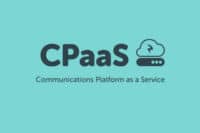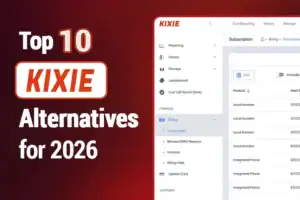Communication is at the center of today’s business world, as well as a critical differentiator in this dynamic and competitive market, which has been altered by the epidemic. Real-time communication has become a way of living thanks to the arrival of broadband Internet and a growing generation of know-hows. While integrating real-time communication into any application is economically significant, it may also be problematic due to the high cost of infrastructure and back-end interfaces.
Small and medium-sized contact centers, in particular, may find this burdensome. So, what’s the best way to close this gap? How can you deploy real-time communication across various channels without blowing your budget? Take use of the cloud, that’s the easy answer! CPaaS (communications-platform-as-a-service) is a cloud-based solution that allows you to integrate real-time communication techniques into your existing apps without worrying about infrastructure or back-end interfaces.
What exactly is a CPaaS?

CPaaS is a cloud-based communication solution with an API enabling simple integration with any current app.
It includes audio and video chat, monitoring, and other bespoke capabilities that you can integrate into any customer-facing application to let your workers respond to queries and issues from consumers in real time. Simultaneously, analytics may give information on your consumers, workforce productivity, and other topics. It’s an obvious and cost-effective strategy to interact with consumers and establish a long-term connection. And it doesn’t stop there.
Here are some of the reasons why organizations are switching to CPaaS for their communications.
Functions
You can opt to add the following CPaaS functions to your communications stack:
- Outbound telephone calls
- Routing inbound calls
- WebRTC-based telephony
- Messages through text (SMS)
- SIP trunking on demand
- Messaging using multimedia and video
- Messages on social media (such as WhatsApp, Facebook and Twitter)
- Masking of phone numbers (proxy)
Why are more businesses using it?
CPaaS solution is a popular option nowadays since it provides several advantages to enterprises and contact centers. Let’s have a look at a few examples.
Efficiency
Many firms are currently cash-strapped and cautious to invest in new technology. In fact, the pace of technology obsolescence is often seen as a key barrier to organizations investing in costly hardware and software.
However, because CPaaS is a pay-per-use platform, such investments are not required. To deliver real-time communications with customers and coworkers, a corporation just has to link CPaaS to its applications. There are no expenditures associated with infrastructure or development. Businesses and contact centers of all sizes may benefit from the power of cloud communication at a low cost this way.
Out of the box tool

Because CPaaS is a simple platform to use, all you have to do is connect its API into your existing apps. It also comes with a programming framework for tailoring real-time communications to your unique requirements.
Software tools, features, APIs, sample code, thorough documentation, a software development kit (SDK), and more are included with CPaaS solutions to assist your developers in swiftly integrating it into your existing IT environment. Many providers additionally provide developers with technical help 24 hours a day, seven days a week.
Flexibility
The flexibility that CPaaS provides developers and enterprises is another advantage. You may tailor this platform to your clients’ specific requirements and interests. Numerous locations are supported by CPaaS, allowing multiple users to access the service at the same time from distinct, secure settings.
Furthermore, the cloud design allows for rapid upgrades and downgrades, and you only pay for what you use. This is a significant benefit for seasonal enterprises since you don’t have to pay for services you don’t need or utilize.
Improved customer experience
The key benefit of CPaaS is that it aids in the development of long-term client connections by offering a superior customer experience.
You may deliver contextual responses to your clients’ concerns in a way that fascinates them when you integrate these technologies with your existing apps. Some users, for example, may prefer a video help desk that demonstrates the step-by-step approach for fixing a problem, which you can provide using CPaaS.
Overall, you can provide what your consumers want and establish the groundwork for a long-term, loyal connection between your company and its consumers.
Data collection and tracking
You may use CPaaS to track a customer’s journey and experience across several channels because it is a cloud platform that incorporates a variety of services.
This allows you to discover more about your consumers, including their preferences, purchasing patterns, and other information. You may provide individualized service to consumers who would enjoy it if you have such extensive expertise.
What is the difference between CCaaS and CPaaS?
Communications Platform as a Service, or CPaaS, is a cloud-based technology that helps businesses improve their communication capabilities. Contact Center as a Service or CCaaS is a communication platform that is comparable to UCaaS. This technology makes communicating with consumers easier for both small and big contact centers.
Both CCaaS and CPaaS are cloud-based services that attempt to make businesses’ lives easier by simplifying and innovating their communication networks, and it may be perplexing to differentiate between the two.
We breakdown the difference between both in 7 aspects:
| CCaaS | CPaaS | |
|---|---|---|
| Objective | Improves company continuity by allowing consumers to interact with you through their preferred channels. | Allows organizations to design and implement their own communication infrastructure to ensure smooth internal and external connections. |
| Flexibility | Comprehensive and inflexible software that enables dealing with customers simply and quickly. | Provides organizations with high-level freedom in terms of how they deploy communication tools based on their needs. |
| Domain | Useful and efficient for customer-centric businesses. | Focuses on creating a communication link between employees inside an business, as well as customers. |
| Compatibility | Cannot be fragmented for specific usages. | Can be combined with other cloud-based services and channels. |
| Usability | Perfect solution for businesses setting up contact centers because of their technologies lack of flexibility. | Allows organizations to build their contact center software by providing a communication tools such as video calls, instant messaging etc. |
| Customizability | Rigid and requires a lot of changes in the software’s coding? | Customized communication channels according to businesses’ needs and client demands |
| Development Process | Can be integrated with a business contact center software. | For an efficient, you’ll need to assemble a team of developers with certain skill sets. |
The Evolution of CPaaS technology

Developers have found it simpler to design communications apps as programming languages, frameworks, processing power, and the cloud have evolved. Developers may now create a functional communications application in minutes. This would have required months of effort only a few years ago.
In many respects, CPaaS is the logical next step in the growth of unified communications as a service in a world that is becoming increasingly cloud-centric, mobile, and collaborative. CPaaS has emerged in tandem with PaaS, which allows businesses to design and deploy new services without having to worry about back-end infrastructure or user interfaces. CPaaS has followed suit, allowing users to coordinate their communications by using other apps and communications services.
Trends and fields of application
According to the IDC, CPaaS solutions will be a roughly $11 billion industrial area by 2022. This is a significant increase from the industry’s projected size of $2 billion in 2017. Keep in mind that these figures apply to the income of communication platform firms. The estimates do not reflect revenue from firms who add value to these platforms by developing new applications.
Let’s have a look at some of the current CPaaS advancements and fields of application that are already in the works.
Information and Education
Historical sites, educational institutions, representative bodies, and industrial associations are all looking at how virtual reality might be used to organize and enhance meetings, lectures, and demonstrations on CPaaS platforms.
Thanks to broadband and dependable connections, data sharing and whiteboard notes may now be exchanged via the Internet. However, a mixture of video, text, speech, graphics, and live conferencing might still enable folks in rural or poor places have access to education. As a result, CPaaS might enable qualified knowledge leaders to concurrently share their expertise with students and trainees all around the world.
Collaboration in the workplace
Corporate strategy and product development are other sectors suitable for CPaaS expansion. Software businesses are used to putting their development teams in the same building. In recent years, however, telecommuting has gained acceptance in the sector. Only with high-quality collaboration technologies and video chat features is the notion of a dispersed team appropriate for project management.
Solutions like Slack, which were nearly unheard of just a few years ago, today assist teams in collaborating even if their members are physically thousands of miles apart. The virtual office and virtual team are quickly becoming the conventional working style of the future, and CPaaS can help.
The dispersed team model is now being adopted by other industries, such as media and entertainment. Early adopters of new technology and creative work methods are generally found in the software, entertainment, and media industries. Telecommuting is projected to become the norm in larger, more conventional businesses over time.
As CPaaS plays a part in transforming work patterns and lifestyles, the heavy traffic, and lost time caused by centralizing the workforce in downtown commercial areas may soon be a thing of the past.
Cloud platforms

Businesses are swiftly adapting to not having workers in their offices, and they are also adapting to not operating their own on-site servers. Remote server services like AWS and Azure have now become commonplace.
Telecommunications are required for teams using cloud-based applications and working from home. These changes in the workplace make CPaaS services even more important. In effect, they function as the connective tissue in the body of remote and scattered teams, allowing them to collaborate using cloud-based applications on faraway servers while remaining in continual communication.
Security systems
Mobile applications are increasingly being used by online services to enable two-factor authentication as part of increased access controls. More software services are going to rely on CPaaS providers since they wish to add interactive remote security features in their access credentials. This credential data may grow over time to incorporate retina scans, thumbprints, and face recognition, which might effect physical access to facilities.
Police crowd control and prison, patient, student, and employee management also necessitate fast confirmation and distribution of camera material. With IoT and CPaaS, all of these physical security measures may become more advanced.
Realignment of the telecommunications industry
Large corporations have repositioned themselves in recent years to increase their services and take advantage of the CPaaS prospects. For example, in 2012, Telefonica, a Spanish telecommunications company, purchased the messaging application Tokbox.
However, new technologies are not just the realm of major corporations. Because of the emergence of CPaaS, agile, disruptive firms may just as readily come to the forefront of a new technology without significant expenditure. Smaller businesses currently in the telecom industry are well positioned to incorporate this new technology into their present service offerings.
NobelBiz: A complete service for all contact centers

NobelBiz has over 20 years of expertise providing complete, tailored solutions for contact centers all around the world. Regardless of their size, industry, or activity, our services and technical solutions can fulfill the demands of all sorts of contact centers (Inbound, Outbound or Mixed).
Our true omnichannel sofware NobelBiz Omni+ is a contact center software designed for all your needs. Including all communication channels:
- Voice calls,
- Facebook Messenger,
- Twitter,
- WhatsApp, Telegram,
- SMS, email, Live
- Chat,
- Webchat,
- Voice mail.
NobelBiz OMNI+ is built with a complete flexibility and scalability in mind. Our development and engineering teams are ready to design the next integration depending on your individual needs, in addition to our amazing list of integrations.

Abdelmounim Benharouga has always had a strong passion for writing and digital marketing. He started as a Digital Content Writer part of marketing department then moved to being Customer Success Manager for the African Region within the Nobelbiz team.






